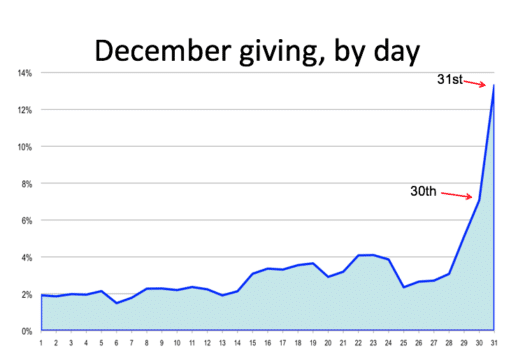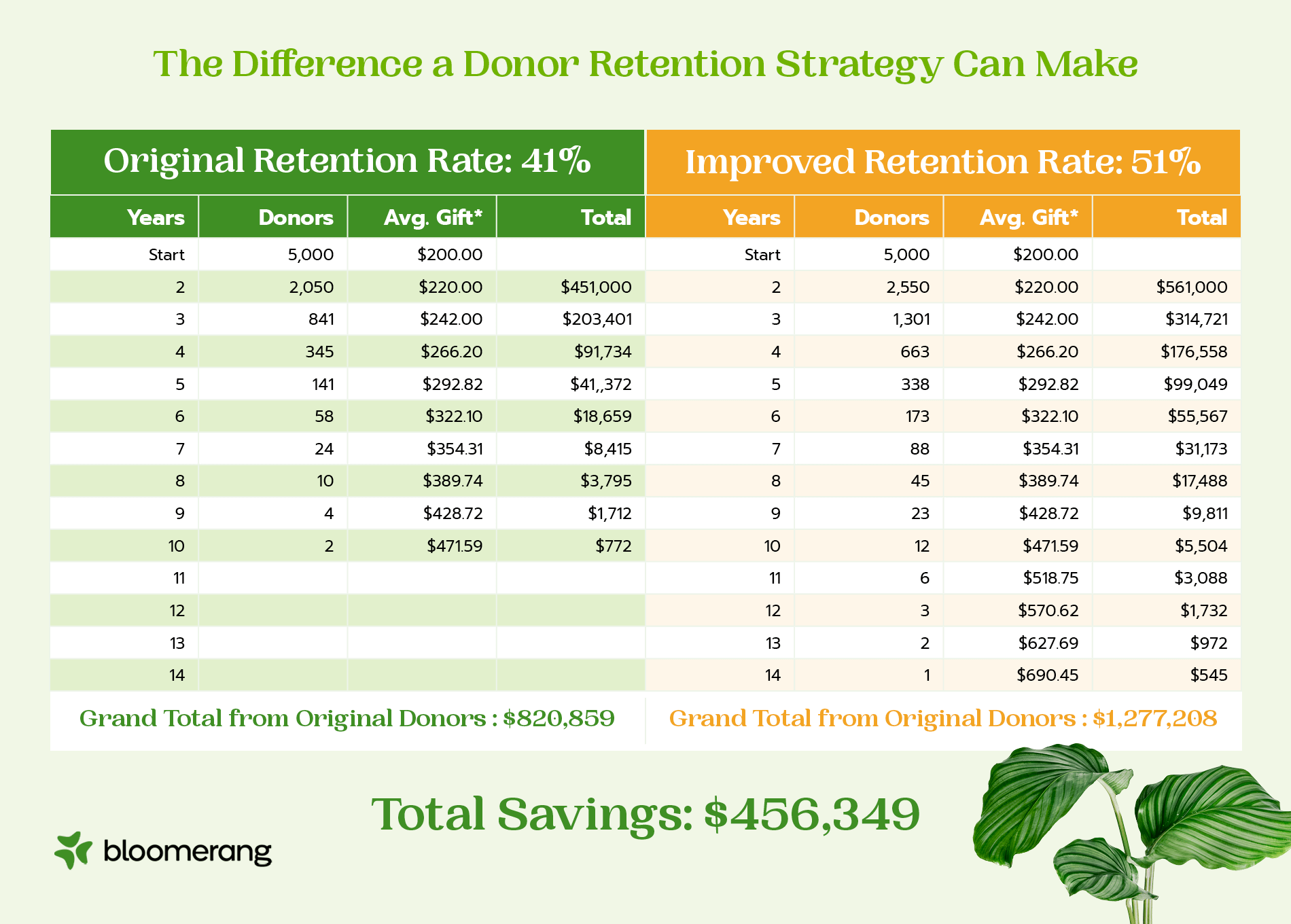GivingTuesday is a global celebration of generosity, community, and collective positive impact. Held the Tuesday after Thanksgiving, this powerful giving movement mobilizes supporters worldwide and sparks a surge in donations right when year-end fundraising picks up.
For nonprofit fundraising professionals like you, GivingTuesday is a prime opportunity to amplify your mission, rally your community, and finish the year strong.
Not sure if your organization is ready to seize the moment? This guide will walk you through everything you need to confidently plan, promote, and profit from GivingTuesday. Here’s what we’ll cover:
- GivingTuesday: Your FAQs answered
- Expert tips to make the most of your GivingTuesday campaign
- 15 fundraising ideas to engage supporters on GivingTuesday
GivingTuesday: Your FAQs answered
What is GivingTuesday?
According to the official website, GivingTuesday is a “global generosity movement unleashing the power of radical generosity.” The name “GivingTuesday” refers to the fundraising event and the nonprofit organization that began the campaign.
Who can participate in GivingTuesday?
Any individual or charitable organization can participate in this giving initiative. Organizations in the U.S. do not have to be 501(c)(3)s as long as they clearly state that supporters’ gifts will not be tax-deductible.
When did GivingTuesday begin?
The first GivingTuesday was held in 2012. It was founded to focus on gratitude and giving back to the community after the shopping-heavy days of Black Friday and Cyber Monday.
When is GivingTuesday 2025?
GivingTuesday 2025 is on Tuesday, December 2, 2025.
How much do nonprofits raise through GivingTuesday?
GivingTuesday 2024 was a record-breaking year, with 36.1 million people donating $3.6 billion to charitable organizations in the U.S. (a 16% donation increase from 2023). According to the GivingTuesday organization, the sum of GivingTuesday donations since its launch in 2012 is more than $18.5 billion.
Do nonprofits have to register to officially participate in GivingTuesday?
You do not need to register with the GivingTuesday organization or any other organization to participate in this giving day. You can independently start a campaign to support your nonprofit and freely collect donations on this day.
Expert tips to make the most of your GivingTuesday campaign
Want to plan a GivingTuesday strategy for your nonprofit? Start here with our top tips for maximizing giving this year.
1. Incorporate GivingTuesday into your year-end giving strategy.
Although GivingTuesday can be an incredible fundraising opportunity for nonprofits, it’s just the beginning of the lucrative year-end fundraising season. Year-end fundraising peaks on December 31 as donors send their final tax-deductible gifts for the year.
The M+R Benchmarks 2025 report found that nonprofits received 40% of their 2024 online revenue in December. The study also determined that nonprofits raised an average of 11% more on December 31, 2024, than on December 31, 2023.

2. Start planning early.
Your nonprofit needs a well-built-out plan for GivingTuesday. We recommend starting the planning process in September. That will give your fundraising team enough time to plan your outreach and refresh your online presence.
Here’s what your 2025 timeline could look like:
- September:
- Select a theme for your GivingTuesday campaign, including unique branding and a hashtag or tagline you’ll use to promote the initiative.
- Segment your donor lists to personalize outreach.
- October:
- Draft email and social media copy, and create a posting calendar.
- Optimize your donation page.
- November:
- Start sending email, direct mail, and social media marketing communications to generate interest in and awareness for your campaign.
- Contact long-time, loyal donors personally to ask them to consider giving.
- Early December/GivingTuesday itself:
- Ramp up communications leading up to GivingTuesday.
- Engage with supporters and continually post throughout the day to thank donors and maintain high engagement.
Meet with your fundraising team regularly throughout these final months of the year to assign tasks, sync on progress made, work through challenges, and ensure total alignment with next actions. Set clear task owners and deadlines for each activity. For instance, you could assign one team member to draft all email and social copy by October 15 to give your team leader enough time to review and approve the content.
3. Optimize your campaign page and donation form.
Your online campaign page should streamline the giving process for your supporters, making it as easy as possible for them to send in their donations. Optimize your GivingTuesday campaign page and donation form by ensuring it has:
- A clear explanation of what your campaign will support (whether purchasing school supplies for kids in need, financing an essential construction project, etc.)
- A fast page loading time to keep users on the page
- Streamlined form questions that just ask for the essentials (like donors’ names, gift amounts, and payment details)
- One or two compelling hero images that spark an emotional connection with your audience
- A mobile-optimized user experience, with spaced-out touch targets and large fonts
- A branded thank-you page with details about how donors’ gifts will support your mission
- A timely donation confirmation email with information about how donors can stay involved with your cause, and an official donation receipt for tax purposes
You can perform A/B testing on your GivingTuesday campaign page to identify the strategies that resonate most with your audience.
For example, you might create one version of the page featuring a single-page form and another version with a multi-step form. Test both pages by sending them to separate groups of donors before GivingTuesday to determine which option generates the highest revenue.
4. Leverage social media.
GivingTuesday is a day dedicated to online giving, making it essential for nonprofits to primarily reach out through digital platforms. Specifically, social media will be your most effective tool for sharing updates about your GivingTuesday campaign.
Use these tips to make the most of your social media presence:
- Recruit social media advocates. Organize a group of influential social media users who are passionate about your cause and have them spread the word. They can post about your campaign and donate to support your efforts.
- Use each platform’s unique features to their fullest potential. Each social media platform has slightly different strengths. For example, Instagram is useful for sharing immediate updates via Stories, while Facebook is effective for sharing your online giving form. Create customized strategies for each platform to reach your audience effectively on those channels.
- Make your GivingTuesday appeal very specific. One way to set your GivingTuesday appeal apart from other campaigns is to make an ask to support a very specific purpose, rather than an unrestricted donation. Consider making Giving Tuesday all about one project or need—something tangible, compelling, and urgent, like a building repair or rushing emergency aid after a natural disaster. Donors will be able to better visualize the tangible impact of their gifts.
Track social media engagement metrics throughout the day, such as likes, shares, comments, and donations. You can use this data to improve future social media campaigns and pivot your strategy on GivingTuesday.
For example, suppose you notice video content performing particularly well throughout the day. In that case, you can focus on sharing more videos of testimonials, behind-the-scenes looks, and campaign updates from your fundraising staff members.
5. Conduct email marketing.
Along with social media, email is another useful platform to contact supporters online. Optimize your email outreach with these best practices:
- Clearly state that the email is about GivingTuesday. Including GivingTuesday in the subject line immediately shows supporters what the rest of the content will be about.
- Use the donor’s name in the introduction. This personal touch establishes a connection with your supporter right off the bat.
- Define GivingTuesday in the message body. Briefly explain what GivingTuesday is for supporters who may not have participated in this type of campaign before.
- Ask for a specific gift amount from supporters. Supporters are more likely to contribute when they know how much your organization needs from them.
- Explain the impact of a donation. Highlight their potential donation’s positive effect, giving supporters a compelling reason to contribute.
- Give supporters a link to your donation page, providing an immediate opportunity to act on your message.
Lastly, use eye-catching subject lines so your emails stand out in recipients’ inboxes. Urgent, personalized appeals tend to be effective for inspiring immediate giving. For instance, a subject line saying “Rebecca, only 12 hours left to get your GivingTuesday gift matched by a generous donor!” is more engaging than one saying “Donate to our GivingTuesday matching gift drive today!”
6. Test the donor journey.
While double-checking the functionality of your donation form may not be the most exciting task in the world, it can save you a lot of heartache. Don’t let half of GivingTuesday pass you by before discovering that donors can’t find your campaign page or your online donation forms aren’t working!
Test the donor journey by answering these questions:
- Is it easy for website visitors to find your donation page? Include a prominent call-to-action button leading to the donation page right in the navigation bar on your website for easy accessibility.
- Does the donation page load quickly on all browsers and devices (especially mobile)? Ensuring the donation page is available on any device means supporters can contribute to the campaign from wherever they are on GivingTuesday directly from their laptops, phones, tablets, or whatever device they have handy.
- Can you fill out the donation form and complete the process without problems? Complete the donation process yourself on different devices to ensure it will work for your donors. Run a small donation on an actual credit card to ensure the payment processing system is effective and timely.
- Are you pleased with the content of the confirmation page? Your confirmation page is an opportunity to thank donors, reassure them that their donations were processed successfully, and provide additional opportunities to maximize contributions, like with a matching gift.
- Is the email confirmation sent out right away? A prompt confirmation email is an immediate way to say “thank you” and provide a gift receipt.
- Is the transaction entered into your donor database automatically? If your organization uses a unified giving platform that includes donor management and fundraising functionality (like Bloomerang), this shouldn’t be a problem. But it’s always worth double-checking that all data flows smoothly between platforms and that your donor database is updated with new donor details.
A streamlined donor journey encourages more GivingTuesday donations and increases donors’ trust in your organization, leading to greater long-term support.
7. Stay active during the event.
Keep in touch with supporters throughout GivingTuesday by planning multiple day-of touchpoints.
Some strategies you might employ to keep in touch with supporters include:
- Posting frequently on social media
- Sending emails throughout the day
- Live-streaming to stay in touch with supporters
- Sharing fundraising thermometers updated with campaign totals
- Posting blog articles and videos with updates about the campaign
Give shoutouts to supporters who go above and beyond to support your campaign. For example, you could share a “Top Donor of the Hour” social media post featuring the most significant gifts from every hour of GivingTuesday. Or, you could host an Instagram Live where you read out donors’ names in real-time as their gifts roll in.
8. Follow up after the campaign to boost retention.
Your GivingTuesday campaign should not only focus on acquiring new donors but also on retaining them for the long term. Check out this example from our donor retention guide showing the impact of a nonprofit increasing its retention rates by just 10%:

As you can see, retaining more donors allows your organization to earn more revenue over time.
Use these strategies to retain different types of GivingTuesday donors:
- Call first-time donors to express your appreciation.
- Send repeat donors a survey asking about their giving experience.
- Send a handwritten thank-you note to new or longtime donors.
- Create a personalized thank-you video and call major donors to show gratitude.
Invite donors into your nonprofit’s community to show them that you care about building real relationships with them as individuals. This approach is a much more effective way to build long-term loyalty than occasional fundraising requests.
9. Analyze campaign performance.
Your nonprofit collects a lot of valuable information throughout GivingTuesday. Don’t let this information simply sit in your database. Instead, analyze campaign results to optimize future efforts.
Review metrics such as:
- The number of first-time donors
- The number of repeat supporters
- Email open and click-through rates
- Activities most participated in
- Total donation amount
With this data, you can determine how effectively your campaign reached new audiences, engaged existing supporters, and supported your mission.
15 fundraising ideas to engage supporters on GivingTuesday
Your GivingTuesday fundraising efforts will be more successful when you offer supporters a compelling reason to get involved. The more engaging or interactive your campaign is, the better! With that in mind, here are some campaign ideas to make your GivingTuesday event a smashing success:
- Peer-to-peer fundraising: Empower supporters to set up personalized fundraising pages and share them with their personal networks via email, social media, and other online platforms.
- Matching gift drive: Use a matching gift database to identify match-eligible donors and follow up with them to request a matching gift.
- T-shirt fundraiser: Create a special branded shirt specifically for celebrating GivingTuesday.
- Wish lists: Provide a registry containing items your nonprofit needs to accomplish your mission. For example, if your mission is to provide food and supplies for people experiencing homelessness, you could create a registry with nonperishable foods, shower products, vitamins, and other useful items.
- Email campaign: Send personalized email outreach to different donor segments. Focus your emails around a central theme, such as sharing testimonials or data about your organization’s impact.
- Crowdfunding: Create and share your optimized campaign page and donation form with a broad audience to inspire small donations from many supporters.
- Livestreamed virtual giving event: Host a fundraising event centered around social media by regularly livestreaming with your supporters. Or, offer an all-day auction, contests, and other activities for them to get involved in and help you raise funds.
- Pledge drive: Start a pledge drive to inspire donors to give during GivingTuesday and once more before the year ends.
- Fundraising letters: Send handwritten letters or personalized emails to advertise ways to get involved in your GivingTuesday campaign.
- Text-to-give campaign: Donors will text a keyword to your nonprofit’s dedicated text-to-give number, and then complete their donation using a link to your giving form.
- Product fundraisers: Sell products like coffee, chocolate, popcorn, cookie dough, or branded merchandise to give supporters a tangible benefit in exchange for their support.
- Silent auction: On GivingTuesday, host a silent auction with catered food, a DJ or other entertainment, and valuable auction items, such as all-inclusive vacations or rare sports memorabilia.
- 5K or fun run: This event can be in person, virtual, or hybrid. Offer prizes for top finishers and create branded merchandise to promote the event.
- Food drive: Collect canned or non-perishable goods from supporters to help build your organization’s community kitchen or pantry supply.
- Challenge fundraiser: Encourage supporters to participate in friendly competitions through peer-to-peer fundraising challenges. Examples include a daily 10,000 steps challenge or a gratitude challenge, where participants share one photo each day for a week of something they are grateful for.
Your organization could choose to focus on one of these ideas or combine multiple strategies into a larger campaign. Consider your fundraising team’s size and capacity when making this decision.
Also, think about what your organization already does well. If your previous text-to-give campaigns have been a smashing success, build on that momentum during your GivingTuesday outreach efforts.
How Bloomerang can support your GivingTuesday success
Bloomerang is the unified, efficient giving platform your organization needs to grow your impact. If you feel pulled in opposite directions leading up to the year-end giving season, Bloomerang can help streamline your planning efforts and free up your time to focus on your mission.
Bloomerang offers the following fundraising tools to ensure your GivingTuesday campaign goes off without a hitch:
- Mobile-first, fast-loading giving forms that you can brand to your nonprofit
- Simple event and auction hosting capabilities to facilitate GivingTuesday events
- AI-powered peer-to-peer fundraising tools to empower supporters to rally their networks in support of your campaign
- Flexible donation options, including credit/debit cards, PayPal, Google Pay, Apple Pay, Venmo, tap-to-pay, and ACH
- Text donations to empower donors to give instantly
- Industry-leading fraud monitoring tools to increase payment processing security
- Nonprofit-savvy support and expert guidance from people who understand your challenges
Plus, Bloomerang’s strong focus on donor retention empowers nonprofits to continue building relationships with new donors even after GivingTuesday ends. Leverage our donor management solution to build on past interactions, personalize your outreach, and identify donors who are ready to upgrade their giving.
Watch this video to learn more about how Bloomerang powers your purpose, helping your organization have a greater impact in its community:
Bloomerang organizes your data and connects essential information across platforms. As a result, your fundraising team can do what it does best—build genuine relationships with supporters that can last a lifetime.
Wrapping up
With an impactful plan, your nonprofit will be ready to rock GivingTuesday this year. Equipped with these expert tips and creative GivingTuesday ideas, you’re off to a great start.
Check out our additional fundraising resources to optimize all aspects of your campaign:
- Email Marketing for Nonprofits: The Ultimate How-To Guide. Craft engaging and inspiring GivingTuesday emails with the help of this comprehensive guide.
- The Essential Nonprofit Fundraiser’s Guide to Mobile Giving. Learn everything you need to know about optimizing your mobile giving efforts ahead of GivingTuesday.
- What is Peer-to-Peer Fundraising? The Ultimate Guide. Plan a fun and effective peer-to-peer fundraiser for your audience by following our expert tips.
The post GivingTuesday 2025: The Ultimate Guide for Nonprofits appeared first on Bloomerang.

